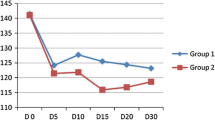Abstract
We investigated the effects of propofol and propofol–ketamine on hemodynamics, sedation level, and recovery period in pediatric patients undergoing cardiac catheterization. We performed a prospective, randomized, double-blind study. The study included 60 American Society of Anesthesiologists physical status II or III (age range, 1 month–13 years) undergoing cardiac catheterization for evaluation of congenital heart disease. Propofol and ketamine were prepared in 5% glucose solution to a final concentration of 5 and 1 mg/ml, respectively; similar injectors containing 5% glucose solution only were prepared. Fentanyl (1 μg/kg) and propofol (1.5 mg/kg) were given to both groups. Then, group 1 received 0.5 ml/kg of 5% glucose and group 2 0.5 ml/kg of ketamine solution by an anesthesiologist who was unaware of the groups of patients. Local anesthesia with 1% lidocaine was administered before intervention in all patients. The noninvasively measured mean arterial pressure, heart rate, respiratory rate, and peripheral oxygen saturation were recorded at the baseline, following drug administration, at 3, 5, 10, 15, 20, and 30 minutes and then at 15-minute intervals until the end of the procedure. Additional drug and fentanyl requirements to maintain a sedation level of 4 or 5 were recorded. After the procedure, the time to a Steward recovery score of 6 and adverse effects in the first 24 hours were recorded. The number of patients with more than a 20% decrease in mean arterial pressure was 11 in group 1 and 3 in group 2 (p < 0.05). The number of patients who experienced more than a 20% decrease in heart rate was 12 in group 1 and 5 in group 2 (p = 0.054). Ten patients in group 1 and 3 patients in group 2 required additional fentanyl doses (p = 0.057). The number of additional propofol doses was lower in group 2 (p < 0.05). Propofol combined with low-dose ketamine preserves mean arterial pressure better without affecting the recovery and thus is a good option in pediatric patients undergoing cardiac catheterization.


Similar content being viewed by others
References
SM Auden WL Sobezyk RE Solinger LJ Goldsmith (2000) ArticleTitleOral ketamine/midazolam is superior to intramuscular meperidine, promethazine, and chlorpromazine for pediatric cardiac catheterization Anesth Analg 90 299–305 Occurrence Handle10648310 Occurrence Handle1:CAS:528:DC%2BD3cXhtV2nsb4%3D
CS Aun RY Sung ME O'Meara TG Short TE Oh (1993) ArticleTitleCardiovascular effects of i.v. induction in children: comparison between propofol and thiopentone Br J Anaesth 70 647–653 Occurrence Handle8329259 Occurrence Handle1:STN:280:ByyA3MbosVc%3D
S Badrinath MN Avramov M Shadrick TR Witt AD Ivankovich (2000) ArticleTitleThe use of a ketamine–propofol combination during monitored anesthesia care Anesth Analg 90 858–862 Occurrence Handle10735789 Occurrence Handle1:CAS:528:DC%2BD3cXis1yisbw%3D
WJ Berman RR Fripp M Rubler L Alderete (1990) ArticleTitleHemodynamic effects of ketamine in children under cardiac catheterization Pediatr Cardiol 11 72–76 Occurrence Handle2349145 Occurrence Handle10.1007/BF02239565
DL Coppel JW Dundee (1972) ArticleTitleKetamine anesthesia for cardiac catheterization Anaesthesia 27 25–31 Occurrence Handle5007628 Occurrence Handle1:STN:280:CS2D1c3nsVc%3D
RJ Dachs GM Innes (1997) ArticleTitleIntravenous ketamine sedation of pediatric patients in the emergency department Ann Emerg Med 29 146–150 Occurrence Handle8998094 Occurrence Handle1:STN:280:ByiC2M3hs1Y%3D
A Dönmez A Kizilkan H Berksun B Varan K Tokel (2001) ArticleTitleOne center's experience with remifentanil infusions for pediatric cardiac catheterization J Cardiothorac Vasc Anesth 15 736–739 Occurrence Handle11748523
NS Faithfull R Haider (1971) ArticleTitleKetamine for cardiac catheterization Anaesthesia 26 318–323 Occurrence Handle5090227 Occurrence Handle1:STN:280:CS6B3s%2FmtVM%3D
RH Friesen M Alswang (1996) ArticleTitleChanges in carbon dioxide tension and oxygen saturation during deep sedation for paediatric cardiac catheterization Paediatr Anaesth 6 15–20 Occurrence Handle8839083 Occurrence Handle1:STN:280:BymH3snhvFM%3D
D Gozal AJ Rein A Nir Y Gozal (2001) ArticleTitlePropofol does not modify the hemodynamic status of children with intracardiac shunts undergoing cardiac catheterization Pediatr Cardiol 22 488–490 Occurrence Handle11894151 Occurrence Handle10.1007/s002460010280 Occurrence Handle1:STN:280:DC%2BD387mtVWrtg%3D%3D
SM Green N Kuppermann SG Rothrock CB Hummel M Ho (2000) ArticleTitlePredictors of adverse events with intramuscular ketamine sedation in children Ann Emerg Med J 35 35–42 Occurrence Handle1:STN:280:DC%2BD3c%2Fot1Onsg%3D%3D
S Lebovic DL Reich GL Steinberg FP Vela G Silvay (1992) ArticleTitleComparison of propofol versus ketamine for anesthesia in pediatric patients undergoing cardiac catheterization Anesth Analg 74 490–494 Occurrence Handle1554114 Occurrence Handle1:STN:280:By2B3cnmtlc%3D
JP Morray AM Lynn SJ Stamm et al. (1984) ArticleTitleHemodynamic effects of ketamine in children with congenital heart disease Anesth Analg 63 895–899 Occurrence Handle6486488 Occurrence Handle1:STN:280:DyaL2M%2FitVOltA%3D%3D
RF Mortero LD Clark MM Tolan et al. (2001) ArticleTitleThe effects of small-dose ketamine on propofol sedation: respiration, postoperative mood, perception, cognition, and pain Anesth Analg 92 1465–1469 Occurrence Handle11375826 Occurrence Handle1:CAS:528:DC%2BD3MXksVyht7g%3D
NK Nguyen S Magnier G Georget et al. (1991) ArticleTitleAnesthesia for heart catheterization in children, comparison of 3 techniques Ann Fr Anesth Reanim 10 522–528 Occurrence Handle1785701 Occurrence Handle1:STN:280:By2C2M3ks1Q%3D
RI Parker RA Mahan D Guigliano M Parker (1997) ArticleTitleEfficacy and safety of intravenous midazolam and ketamine as sedation for therapeutic and diagnostic procedures in children Pediatrics 99 427–431 Occurrence Handle9041300 Occurrence Handle10.1542/peds.99.3.427 Occurrence Handle1:STN:280:ByiC1MzntFE%3D
MAE Ramsey TM Savege BR Simpson R Goodwin (1974) ArticleTitleWith controlled sedation alphaxalone–alphadolone Br Med J 2 656–659
DL Reich G Silvay (1989) ArticleTitleKetamine: an update on the first 25 years of clinical experience Can J Anesth 1 387–400
I Smith PF White M Nathanson R Gouldson (1994) ArticleTitlePropofol Anesthesiology 81 1005–1043 Occurrence Handle7943815 Occurrence Handle1:STN:280:ByqD3s%2FktFA%3D
DJ Steward (1975) ArticleTitleA simplified scoring system for the postoperative recovery room Can Anaesth Soc J 22 111–113 Occurrence Handle1109700 Occurrence Handle1:STN:280:CSqD2szoslE%3D Occurrence Handle10.1007/BF03004827
JE Wathen MG Roback T Mackenzie JP Bothner (2001) ArticleTitleDoes midazolam alter the clinical effects of intravenous ketamine sedation in children? A double-blind, randomized, controlled, emergency department trial West Afr J Med 20 136–139
GD Williams TK Jones KA Hanson JP Morray (1999) ArticleTitleThe hemodynamic effects of propofol in children with congenital heart disease Anesth Analg 89 1411–1416 Occurrence Handle10589618 Occurrence Handle1:CAS:528:DC%2BD3cXhsF2jsA%3D%3D
Author information
Authors and Affiliations
Corresponding author
Rights and permissions
About this article
Cite this article
Akin, A., Esmaoglu, A., Guler, G. et al. Propofol and Propofol–Ketamine in Pediatric Patients Undergoing Cardiac Catheterization. Pediatr Cardiol 26, 553–557 (2005). https://doi.org/10.1007/s00246-004-0707-4
Published:
Issue Date:
DOI: https://doi.org/10.1007/s00246-004-0707-4




